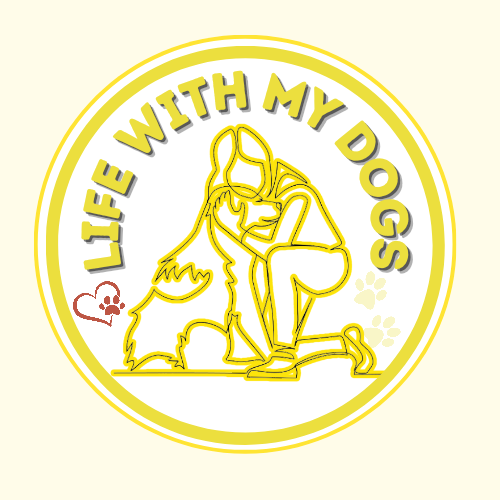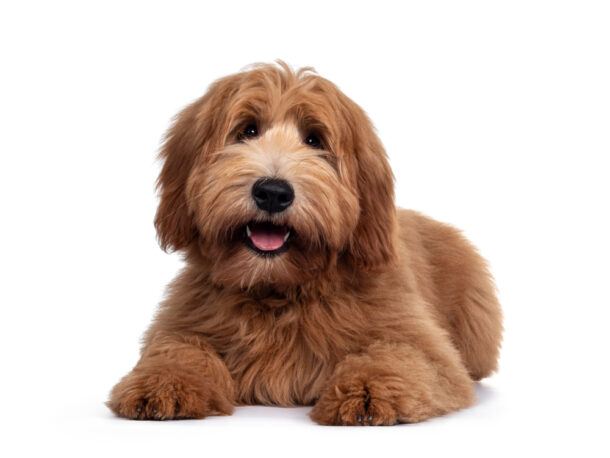LifeWithMyDogs is supported by our audience. When you purchase through one of our links, we may earn a small affiliate commission. As an Amazon Associate I earn from qualifying purchases. Your cost is not affected.
**********
Dog restless and panting? It can be unsettling to see your beloved canine companion exhibiting these signs of distress. While panting is a normal way for dogs to regulate their body temperature, excessive panting or restlessness can sometimes indicate a deeper issue.
This article will delve into the various reasons why senior dogs might experience these symptoms, helping you navigate the potential causes and identify the best course of action. We’ll explore common medical conditions, anxiety triggers, and environmental factors that can contribute to restlessness and panting. More importantly, we’ll equip you with strategies to manage these symptoms, improve your senior dog’s comfort, and ensure they live a happy and relaxed golden age.
Senior Dog Restless and Panting: Understanding and Managing Late-Life Anxiety
As dogs age, their behaviors and health needs can change, often presenting challenges for pet owners.
Senior dogs may exhibit symptoms such as restlessness and panting, which can stem from various underlying conditions.
It’s important to understand that these signs can indicate anything from normal aging to more serious health issues.
Recognizing and responding to these symptoms can improve the quality of life for our elderly canine friends.

Determining the cause of an aged dog’s restlessness and panting requires a methodical approach.
A good starting point is observing when these symptoms occur and any other accompanying signs.
While some causes may be benign, such as slight discomfort or overexertion, others may be indicative of pain, anxiety, or health conditions like Cushing’s disease or respiratory disorders.
Seeking veterinary evaluation is critical for an accurate diagnosis and to ensure that the senior dog receives the most effective treatment.
Key Takeaways
- Restlessness and panting in senior dogs can signify various health issues.
- Observing the context of symptoms helps in identifying potential causes.
- Veterinary support is essential for diagnosis and determining the right treatment.

Understanding Senior Dog Restlessness
Restlessness in senior dogs can stem from a variety of causes, reflecting either physical discomfort or emotional distress. Recognizing the symptoms and understanding the common reasons can lead to appropriate interventions.

Common Causes of Restlessness
- Medical Issues: Conditions such as canine dementia, arthritis, and vision or hearing loss can make a senior dog uncomfortable, leading to restlessness.
- Environmental Factors: A change in routine or environment can unsettle an older dog, causing anxiety that manifests as restlessness.
Symptoms of Anxiety and Discomfort
- Sudden changes in behavior, such as refusal to lie down.
- Visible signs of distress, like pacing or shuffling, especially in an environment where they previously felt secure.
Panting as a Sign of Distress
- Normal vs. Stressful Panting: While panting is a natural cooling mechanism, excessive panting, especially during cool conditions or at rest, may indicate discomfort or pain.
- Correlation with Circumstances: Panting that increases with no clear reason, such as nighttime distress, should be closely monitored, as it can be a symptom of more significant health issues.
Veterinary Assessment and Diagnosis
When a senior dog exhibits signs of restlessness and panting, a thorough veterinary assessment and accurate diagnosis are paramount.
Veterinarians approach this with a sequential method, starting with a physical exam, reviewing the dog’s health history, and proceeding to diagnostic tests when necessary.
Physical Examination
The veterinarian will conduct a comprehensive physical exam, which includes listening to the dog’s heart and lungs, checking for any signs of pain or discomfort, and examining the dog’s gums for color changes which might indicate a circulation or oxygenation problem.
Their expertise allows them to detect subtle abnormalities that may point to underlying conditions.
Health History Review
A detailed review of the dog’s health history is crucial.
The veterinarian will inquire about the onset and duration of the panting and restlessness, prior medical conditions such as arthritis or hip dysplasia, and any recent changes in the dog’s environment or routine that may contribute to stress or anxiety.
Diagnostic Tests
Depending on the initial findings, diagnostic tests may be recommended. These can include:
- Bloodwork: To check for signs of infection, inflammation, or organ dysfunction.
- Imaging (X-rays, Ultrasound): To examine the dog’s internal organs and bones for any abnormalities such as tumors or heart enlargement.
- Specific Tests for Conditions: Testing for diseases like Cushing’s Disease or assessing the level of oxygen in the blood if respiratory issues are suspected.
Treatment Options
When seeking relief for a senior dog experiencing restlessness and panting at night, there are several targeted approaches to consider. These span from medical interventions to behavioral strategies and adjustments within the home environment.
Medications and Supplements
Veterinarians may prescribe medications to manage underlying conditions causing discomfort or anxiety.
For example, if a dog is diagnosed with age-related anxiety, an anxiolytic medication may be considered.
In some cases, supplements can also support a dog’s wellbeing, such as those promoting joint health, which might reduce physical discomfort leading to restlessness.
- Common Medications:
- Anxiolytics for anxiety
- Pain relievers for arthritis or other chronic pain
- Supplements:
- Glucosamine for joint health
- Omega-3 fatty acids for inflammation
Behavioral Therapies
Behavioral therapies can be effective, especially when the restlessness is rooted in anxiety or cognitive decline.
Techniques like desensitization and counterconditioning can help a dog adjust to stressors.
Creating a routine for exercise and mental stimulation may reduce nighttime restlessness by promoting daytime activity and better sleep patterns.
- Therapies Include:
- Desensitization to stressors
- Counterconditioning for anxiety triggers
- Cognitive exercises for mental stimulation
Environmental Modifications
Creating a comfortable and stress-free environment is vital.
Simple modifications, such as moving a pet’s bed to a cooler location, can alleviate panting due to overheating.
Calming supplements or a calming bed can also make a significant difference in a senior dog’s ability to rest.
- Adjustments at Home:
- Ensuring a quiet, cozy sleeping area
- Regulating indoor temperatures
- Providing orthopedic bedding for joint support
Home Care Strategies
In addressing senior dog restlessness and panting, home care strategies entail creating a supportive environment that focuses on routine, comfort, and stability. These measures can significantly aid in managing a senior dog’s symptoms.

Regular Exercise Routine
Establishing a regular exercise routine is vital.
Too little activity can contribute to stress and anxiety, which may manifest as restlessness and panting.
A balance of gentle walks and playtime, tailored to the dog’s capabilities and endurance, can help maintain their physical and mental well-being.
Comfortable Resting Area
Providing a comfortable resting area for a senior dog is crucial.
It should be quiet, warm, and away from drafts, with easy access to fresh water.
An orthopedic pet bed can offer support for aging joints, potentially reducing discomfort that could otherwise lead to panting and restlessness.
Consistent Schedule
A consistent schedule plays a key role in home care.
Dogs thrive on predictability, and senior dogs, in particular, may become anxious without it.
Maintaining consistent times for meals, walks, bedtime, and other daily activities can provide a sense of security and reduce anxiety-driven behaviors.
When to Seek Immediate Care

Owners should be aware that certain symptoms in a senior dog can suggest urgent health issues requiring immediate veterinary attention.

Signs of Heatstroke
Senior dogs are more susceptible to heatstroke, which can be fatal if not treated promptly. Key indicators include:
- Excessive panting not aligned with the room temperature
- Gums: Color changes to gums, turning either pale, blue, or bright red
- Agitation or lethargy: Displaying unusual distress or unresponsiveness
For guidance on managing heatstroke and identifying critical signs, refer to Senior Dog Panting at Night: Understanding and Addressing Nighttime ….
Symptoms of Severe Pain
A senior dog in severe pain may exhibit signs such as:
- Changes in posture: They may be hunched over or reluctant to move.
- Vocalizing: Whining or howling, especially if it’s a new behavior.
Difficulty Breathing
Difficulty breathing may indicate serious respiratory or cardiovascular issues.
Symptoms include:
- Labored breathing: It may appear more abdominal or involve heaving sides.
- Change in breathing sound: Wheezing, choking or coughing sounds when breathing.
Immediate veterinary care can make a significant difference, as elaborated in Senior Dog Panting at Night? Our Veterinarians Share What to Do.
Dog Restless and Panting: A Recap and Path Forward
As we’ve explored, a dog restless and panting can be a cause for concern, but it doesn’t necessarily signify a dire situation. We’ve delved into the various reasons behind this behavior in senior dogs, from age-related anxieties to underlying health conditions. We’ve also discussed how environmental factors can play a role.

The key takeaway? By understanding the potential causes and observing the context of your dog’s symptoms, you can navigate this challenge effectively. Veterinary guidance is crucial for pinpointing the root cause and ensuring your senior friend receives the most appropriate treatment. Whether it’s medical intervention, behavioral adjustments, or tweaking your home environment, there are solutions to improve your dog’s well-being. Remember, a dog restless and panting often signifies a need – for medical attention, a more comfortable environment, or simply some reassurance. By following the tips outlined in this article, you can create a more peaceful and comfortable golden age for your furry companion.
Frequently Asked Questions
In senior dogs, panting and restlessness can be a sign of various conditions.
It is important to observe when and how often these symptoms occur to address potential health issues.
Why does my senior dog pant excessively, especially during the night?
It’s a normal cooling mechanism, but if it’s excessive, it might indicate a health problem.
What can be causing my elderly dog to be restless and pant?
How can I tell if my senior dog's panting is a sign of pain or suffering?
What should I do if I notice my older dog is panting heavily and showing signs of anxiety?
Could excessive water drinking and panting be indicative of an underlying health issue in my senior dog?
What are the possible reasons for my senior dog's pacing and restlessness combined with panting?
Related Reading


